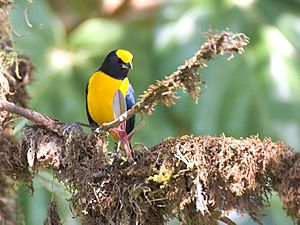Orange-bellied Euphonia facts for kids
Quick facts for kids Orange-bellied Euphonia |
|
|---|---|
 |
|
| Conservation status | |
| Scientific classification | |
| Kingdom: | |
| Phylum: | |
| Class: | |
| Order: | |
| Family: | |
| Genus: |
Euphonia
|
| Species: |
E. xanthogaster
|
| Binomial name | |
| Euphonia xanthogaster Sundevall, 1834
|
|
The Orange-bellied Euphonia (Euphonia xanthogaster) is a small, colorful bird. It belongs to the finch family, known as Fringillidae. This bird was first described in 1834 by Carl Jakob Sundevall.
Contents
Where the Orange-bellied Euphonia Lives
This beautiful bird makes its home in several countries in South and Central America. You can find it in Bolivia, Brazil, Colombia, Ecuador, Guyana, Panama, Peru, and Venezuela.
Natural Homes and Habitats
The Orange-bellied Euphonia prefers specific types of environments. Its natural homes are usually moist lowland forests. These are forests found in warm, wet areas close to the equator. It also lives in moist montane forests. These are forests found on the sides of mountains, where it is still warm and wet.
The bird enjoys both subtropical and tropical climates. This means it likes places that are warm all year round. These areas often have a lot of rain, which helps the forests grow thick and green.
What Orange-bellied Euphonias Look Like
Orange-bellied Euphonias are known for their bright colors. The males often have shiny blue-black feathers on their backs. Their bellies are a striking orange or yellow color. This is how they get their name! Females usually have duller colors. They might be more olive-green with a lighter belly. This helps them blend in with their surroundings.
Size and Appearance Details
These birds are quite small, like many finches. They have short, strong beaks. Their beaks are perfect for eating fruits and insects. Their small size helps them move easily through thick forest leaves.
What Orange-bellied Euphonias Eat
Euphonias are mostly frugivores. This means they love to eat fruit! They especially enjoy small berries and other soft fruits found in the forest. Their diet helps spread seeds. This is important for the health of the forest.
Finding Food in the Forest
They often forage high up in the trees. They move quickly from branch to branch. Sometimes, they also eat small insects. Insects provide important protein, especially during breeding season.
Behavior and Sounds
Orange-bellied Euphonias are often seen in pairs or small groups. They can be quite active. They flit through the canopy, looking for food.
Their Songs and Calls
These birds have a variety of calls and songs. Their sounds are often high-pitched and musical. They use these calls to communicate with each other. They might call to find a mate or warn others about danger.
Life Cycle and Reproduction
Like most birds, Orange-bellied Euphonias build nests. They lay eggs, and the parents take turns caring for the young.
Raising Young Birds
The nests are usually cup-shaped. They are often hidden in dense foliage. This keeps the eggs and chicks safe from predators. The parents work together to feed their babies until they are old enough to fly.
Conservation Status
The Orange-bellied Euphonia is currently listed as a species of "Least Concern." This means their populations are stable. They are not considered to be in immediate danger of extinction.
Protecting Their Habitat
However, like many forest birds, they depend on healthy forests. Protecting their natural habitats is important. This ensures they continue to thrive in the wild.
See also
 In Spanish: Fruterito azulejo para niños
In Spanish: Fruterito azulejo para niños


